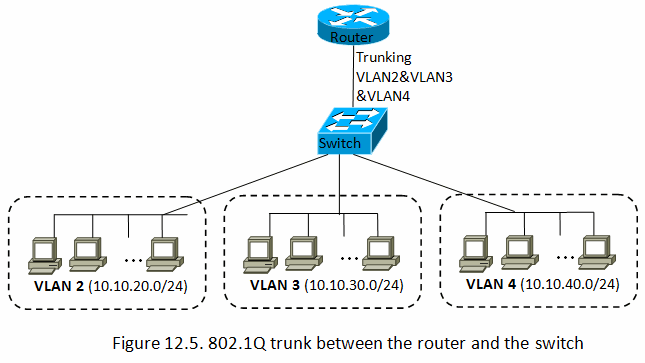VLANs
IEEE 802.1Q IEEE 802.1Q is the networking standard that supports Virtual LANs (VLANs) on an Ethernet network (Layer 3 networking).
The advantages of a VLAN are:
- increased switching efficiency
- network segmentation
- security
- trunks
- ability to sub-divide a LAN for security purposes
In order to use VLAN's you need:
- a switch that supports IEEE 802.1Q
- a NIC (Network Interface Card) that supports 802.1Q (Not all network drivers support VLAN)
- 802.1Q support in the kernel (8021q module, CONFIG_VLAN_8021Q)
VLANs work by applying a tag to each frame (which increases the header size by 4 bytes). The tag contains an 'ID' and a 'prority'. The priority can be used for a quality of service (QoS) scheme known IEEE 802.1p.
Only portions of a network which are VLAN-aware (802.1Q compliant) can include VLAN tags - traffic on other segments (802.1D conformant) will not contain tags. When a frame enters the VLAN-aware portion a tag is added to denote the VLAN info (membership etc).
In general, you add a VLAN tag to a network port (on a managed switch, for example), and that switch port will drop all packets that don't have the specified VLAN ID, while allowing those with the appropriate VLAN ID to continue on.
Here is an image showcasing a potential use case for VLANs:
Generally speaking, VLAN tagging is done on a switch basis, though you can also use Linux to listen to VLAN tagged packets on interface devices.
Linux VLAN support
The Linux network layer supports VLAN if built with CONFIG_VLAN_8021Q. To create a VLAN you need to slave it off a physical interface port. Note that the physical interface will still accept 'un-tagged' traffic, but only traffic matching the VLAN ID will be presented to the virtual interface.
The Linux ip utility from the ip-route2 package allows the manipulation of the network stack on the Layer 3 network layer.
Examples:
- use
ip link addto create VLAN ID 5 slaved off physical interface eth0:ip link add link eth0 name eth0.5 type vlan id 5 ifconfig eth0.5 192.168.1.100 up
- use
ip link setto re-configure the VLAN: - use
ip link showto show the sate of a VLAN:$ ip -d link show eth0.5 5: eth0.1@eth0: <BROADCAST,MULTICAST,UP,LOWER_UP> mtu 1500 qdisc noqueue state UP mode DEFAULT group default link/ether f8:bc:12:8c:23:21 brd ff:ff:ff:ff:ff:ff promiscuity 0 vlan protocol 802.1Q id 5 <REORDER_HDR>
eth0.1@eth0is using the IEEE 802.1Q standard with VLAN id 42.
- use tcpdump to show information when you receive a packet on this nic with the VLAN ID of 5:
tcpdump -i eth0 -Uw - | tcpdump -en -r - vlan 5
- delete a VLAN interface:
ifconfig eth0 down ip link delete eth0.5
See ip(8) or here for more info
Alternatively the Linux vconfig (which is a bit older and deprecated) can be used as well.
Examples:
- create VLAN ID 5 slaved off physical interface eth0:
vconfig add eth0 5 ifconfig eth0.5 192.168.1.100 up
- show info about a VLAN ID (older kernels only):
# cat /proc/net/vlan/config VLAN Dev name | VLAN ID Name-Type: VLAN_NAME_TYPE_RAW_PLUS_VID_NO_PAD eth0.5 | 5 | eth0 # cat /proc/net/vlan/eth0.5 eth0.5 VID: 5 REORDER_HDR: 1 dev->priv_flags: 1 total frames received 4 total bytes received 252 Broadcast/Multicast Rcvd 0 total frames transmitted 8 total bytes transmitted 688 Device: eth0 INGRESS priority mappings: 0:0 1:0 2:0 3:0 4:0 5:0 6:0 7:0 EGRESS priority mappings:
- remove VLAN ID 5
vconfig rem eth0.5
See vconfig(8) for more info
Hardware Support
Many Gateworks products have ethernet MAC's or switch devices that support VLAN tagging.
Ventana
All on-board NIC's on Ventana boards support 802.1Q VLAN Tagging:
- Freescale FEC (eth0 on most boards)
- Marvell Sky2 (eth1 on GW54xx/GW53xx)
- Intel i210 (igb driver) (eth0 and eth1 on GW5520 and MAC on GW16083)
The Ventana GW16083 Ethernet Expansion Mezzanine supports VLAN tagging in the OpenWrt BSP via swconfig as well as DSA support.
OpenWrt VLAN support (swconfig)
OpenWrt has its own light-weight application and kernel driver that configures 'embedded switches' and supports per-port management including VLAN configuration. Being light-weight it does not represent each port as a network interface and thus you can not sun higher level protocols such as STP, LLDP, etc on a per-port basis (for that, see #dsa below).
Please see our OpenWrt swconfig page for more details.
Linux Distributed Switch Architecture
The Linux Distributed Switch Architecture (DSA) is a framework for Ethernet Switch chips present on Embedded boards. When supported each external port of the switch is available as a Network Interface Card (NIC) such that higher level protocols can act at the port level.
In other words each physical port on the switch becomes a network interface in Linux and this allows protocols such as STP, LLDP, etc to run at a port level.

